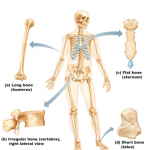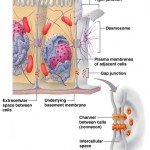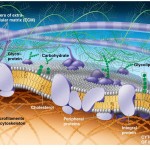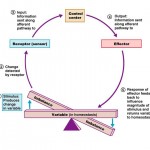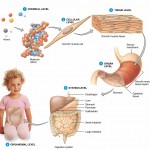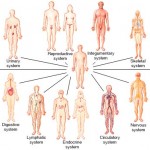The Salivary Glands
The Salivary Glands
Several glands associated with the oral cavity secrete saliva.
Saliva:
- Cleanses the mouth
- Helps moisten and compact food into a round mass called a bolus
- Contains enzymes that begin the chemical breakdown of starch
- Dissolves food chemicals so they can be “tasted”
Most saliva is produced by major or extrinsic salivary glands that lie outside the oral cavity and empty their secretions into it. Minor or intrinsic salivary glands within the oral cavity alter the output slightly (note: extrinsic glands lie outside of oral cavity, intrinsic glands lie within oral cavity). The major salivary glands are paired and develop from the oral mucosa and stay connected to it by small ducts. The large, triangle shaped parotid gland (par=near, otid=ear) lies anterior to the ear between the skin and masseter muscle. Its main duct opens into the vestibule next to the second upper molar (view the green duct in image above).
Facial nerves run through the parotid gland to muscles in the face used for facial expression. For this reason, surgery on this gland is risky and could cause facial paralysis.
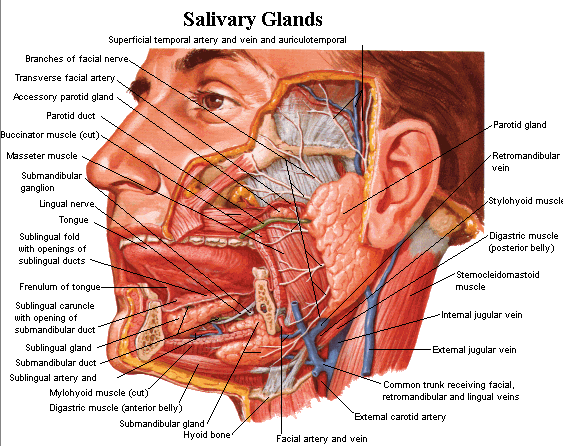
The submandibular, parotid, and sublingual salivary glands in association with the left side of oral cavity.
Mumps, a common disease amongst children, is an inflammation of the parotid glands caused by the mumps (myxovirus) virus. The virus spreads from person to person in saliva. If you view t
he parotid gland in the image above, you will see why people with mumps complain that hurts to chew. Other symptoms include fever and pain when swallowing acidic food or liquid (pickles, grapefruit). Mumps in adult males carries a 25% risk of infecting the testes, which can lead to sterility.
The submandibular gland is about the size of a walnut. Its duct runs underneath the mucosa in the oral cavity floor and opens underneath the tongue at the base of the lingual frenulum. The sublingual gland has a small, almond shape and lies in front of the submandibular gland under the tongue. It has 10-20 ducts which open into the floor of the mouth.
The salivary glands are composed of two types of secretory cells, serous and mucous. Serous cells produce a watery secretion containing ions, enzymes, and a small amount of mucin. Mucous cells produce mucus. The submandibular and parotid glands contain a large percentage of serous cells. The sublingual glands contain mostly mucous cells.
Composition of Saliva
Saliva is mainly water. In fact, it’s 97-99.5% water which makes it hypoosmotic. Its osmolarity depends on the glands that are active and the amount and type of stimulus for salivation. Generally, saliva is a bit acidic (6.75-7.00), but the PH can vary. Its solutes include electrolytes (mainly sodium, potassium, chloride, and bicarbonate); the digestive enzymes salivary amylase and lingual lipase; the proteins mucin, IgA, and lysozyme; metabolic wastes (uric acid, urea). When dissolved in water, the glycoprotein mucin forms thick mucus that lubricates the oral cavity and hydrates foodstuffs.
Saliva protects against microorganisms because it has:
- IgA antibodies
- Lysozyme- a bactericidal enzyme (it inhibits bacterial growth in the mouth and it’s unclear whether or not it may help prevent tooth decay, if you were to experience any issues, call Dentist Sewell straightaway and book an appointment).
- Defensins- defensins function as cytokines and call defensive cells (lymphocytes) into the mouth
Control of Salivation
The minor salivary glands secrete saliva continuously, keeping the mouth optimally moist. When food enters, the major glands activate and large amounts of saliva pour out. The average human being produces around 1500ml of saliva per day, but it can be a great deal higher if the glands are stimulated properly. For the most part, salivation is controlled by the parasympathetic division of the autonomic nervous system. When food is ingested, chemoreceptors and mechanoreceptors in the mouth send signals to the salivatory nuclei in the brain stem to the pons and medulla. As a result, parasympathetic nervous system activity increases. Impulses sent by motor fibers in the facial (VII) and glossopharyngeal (IX) nerves dramatically increase the output of watery saliva.
The chemoreceptors are activated the most by acidic foods and liquids (vinegar, pickles, ect). The mechanoreceptors are activated by almost any type of mechanical stimulus in the mouth (chewing).
Even the sight and smell of food can get saliva flowing. In fact, even the thought of certain foods can make the mouth water! Irritation of the lower gastrointestinal tract can also increase salivation (spicy food, toxins).
In contrast to parasympathetic controls, the sympathetic division causes the release of a thick, mucin-rich saliva. Heavy activation of the sympathetic division constricts blood vessels serving the salivary glands and inhibits the release of saliva, causing dry mouth. Dehydration also inhibits salivation.
Related Posts
Category: Digestive



